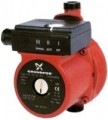Max. flow
The maximum flow of a pump is the amount of liquid it can pump in a certain amount of time.
Features of choosing the optimal performance option depend primarily on the purpose of the pump (see above). For example, for DHW recirculation models, the pump performance should not exceed the performance of the water heater. If the water heater is capable of delivering 10 litres per minute to the DHW circuit, then the maximum pump performance will be 10*60=600 L/h. The basic formula for calculating the performance of a heating system takes into account the power of the heater and the temperature difference at the inlet and outlet, and for the cold water system — the number of points of water intake. More detailed information about the calculations for each application can be found in special sources, and it is better to entrust the calculations themselves to professionals.
Max. head
The head can be described as the maximum height to which a pump can lift liquid through a vertical pipe without bending or branching. This parameter is directly related to the pressure that the pump produces: 10 m of head approximately corresponds to a pressure of 1 bar (do not confuse this parameter with operating pressure — see more about it below).
The head is one of the key specs for most circulation pumps. Traditionally, it is calculated based on the difference in height between the location of the pump and the highest point of the system; however, this principle is relevant only for units that
boost the pressure of cold water(see "Suitable for"). Circulation pumps for heating and DHW work with closed circuits, and the optimal pressure depends on the total hydraulic resistance of the system. Detailed calculation formulas for the first and second cases can be found in special sources.
Max. power consumption
The electrical power consumed by the pump during normal operation and maximum performance.
This indicator directly depends on performance — after all, for pumping large volumes of water, an appropriate amount of energy is needed. And the power depends on two main parameters — electricity consumption and the load on the power grid, which determines the connection rules. For example, pumps with a power of more than 5 kW cannot be connected to ordinary household sockets; more detailed rules can be found in special sources.
Pump housing material
It is the material from which the outer part of the pump housing is made.
—
Stainless steel. As the name suggests, stainless steel is virtually corrosion-resistant. However, this is not its only advantage — this material is very durable and reliable, due to which it is used even in powerful high-performance models.
—
Cast iron. This material is in many ways similar to steel — in particular, it is considered very reliable — but it has a slightly higher weight. On the other hand, in most cases, this is not a noticeable drawback, but cast iron costs a little cheaper than stainless steel.
—
Brass. An alloy based on copper and zinc, which has a golden colour. The varieties used in circulation pumps are highly resistant to corrosion and even surpass stainless steel. Therefore, this option is well suited for water with a high oxygen content. The disadvantage of brass can be called a higher cost than that of the same steel.
—
Bronze. Another copper-based alloy. According to the main features, this material is similar to the brass described above.
— Plastic. Units with plastic housings are lightweight, inert to water, and completely unaffected by corrosion. Moreover, polymer materials allow almost any thickness of the body, which determines the requirements of the mould for casting the workpiece. The di
...sadvantage of plastic is its low mechanical strength. The plastic housing can be damaged on the outside and outside due to any kind of impact.
